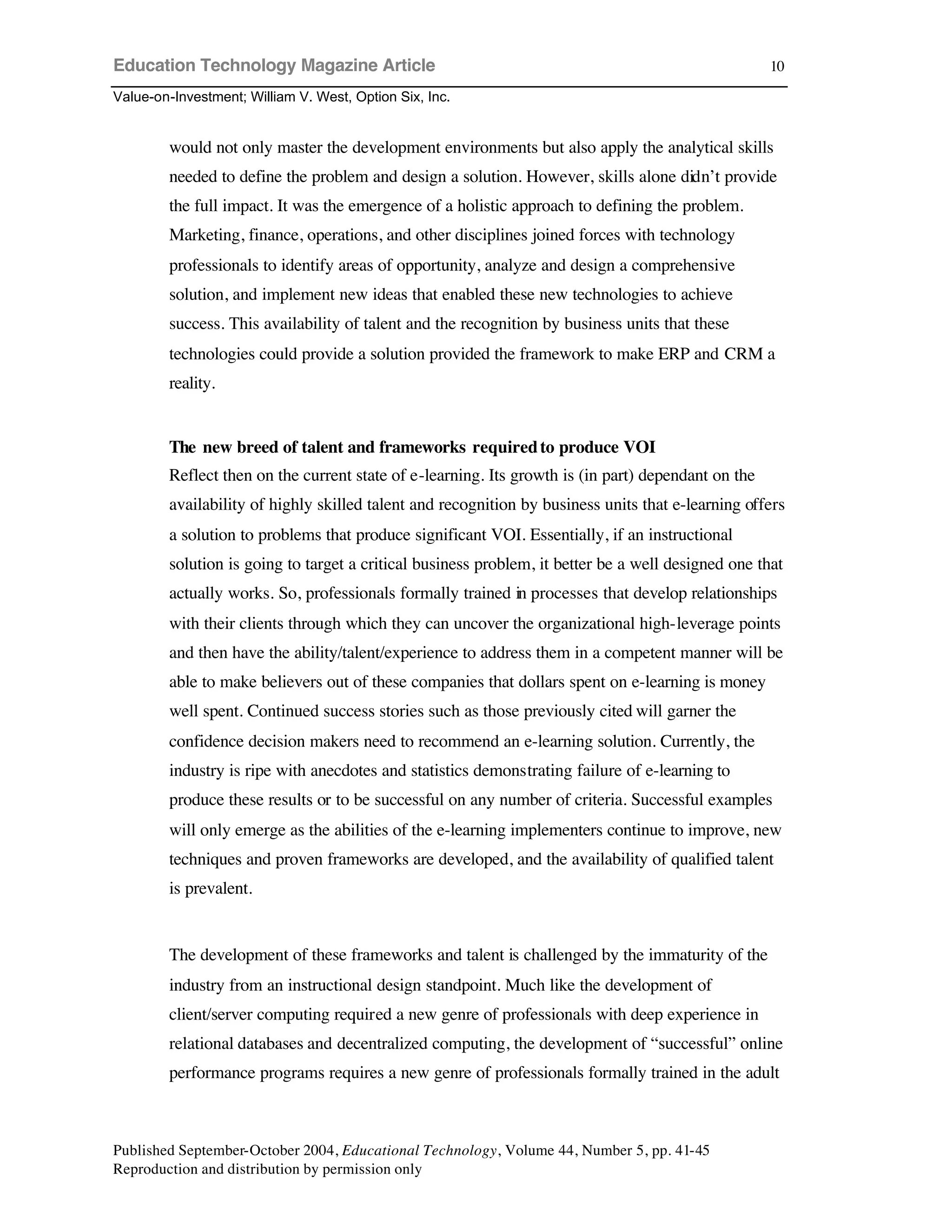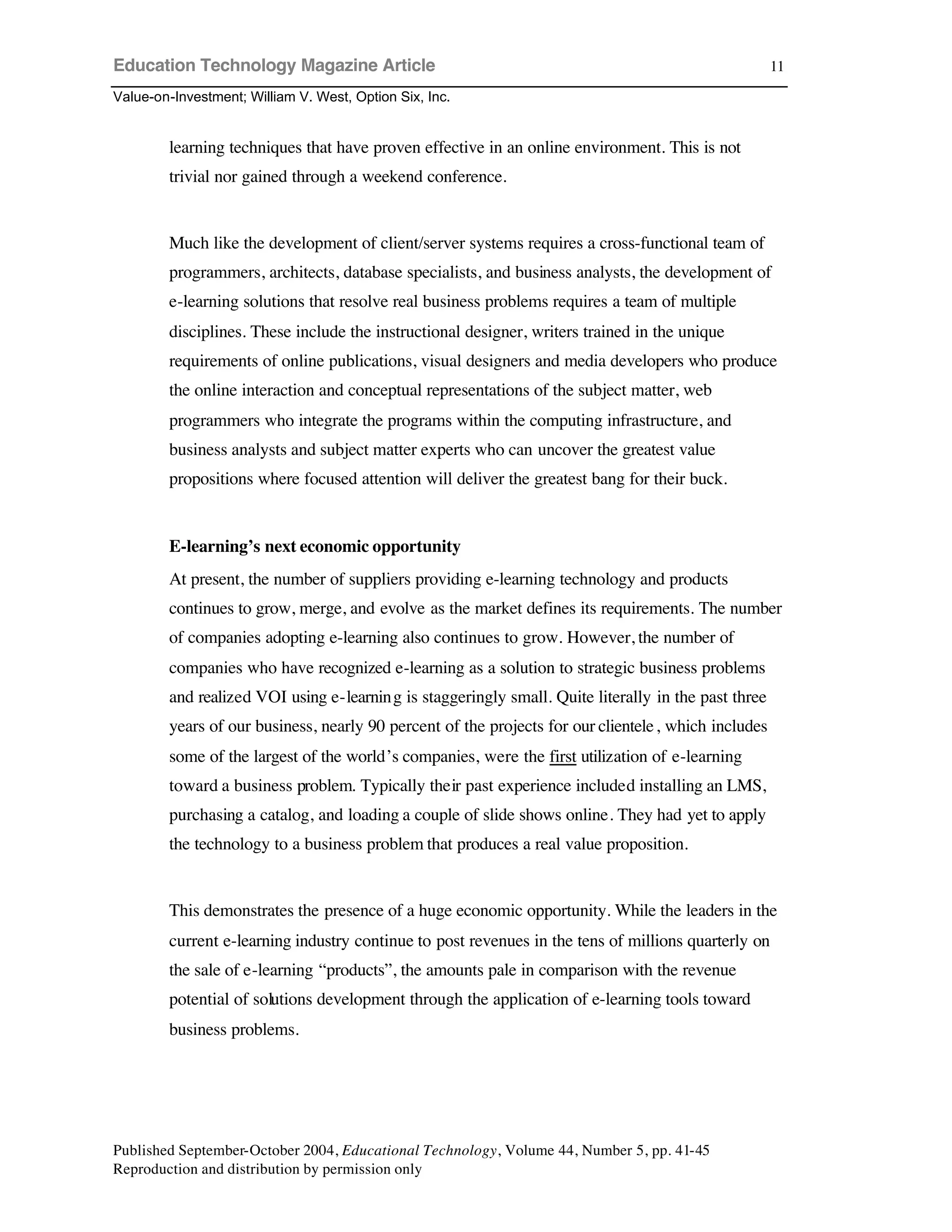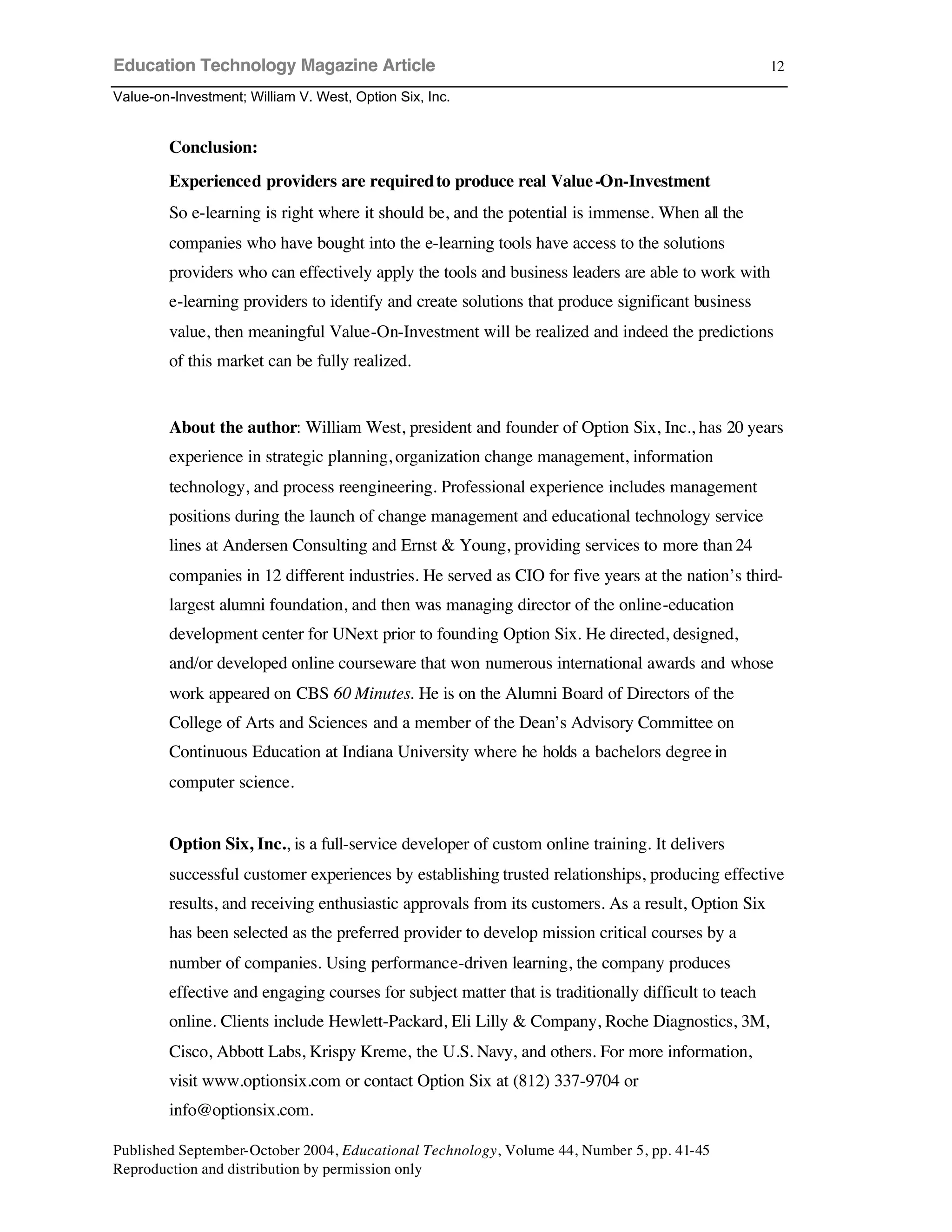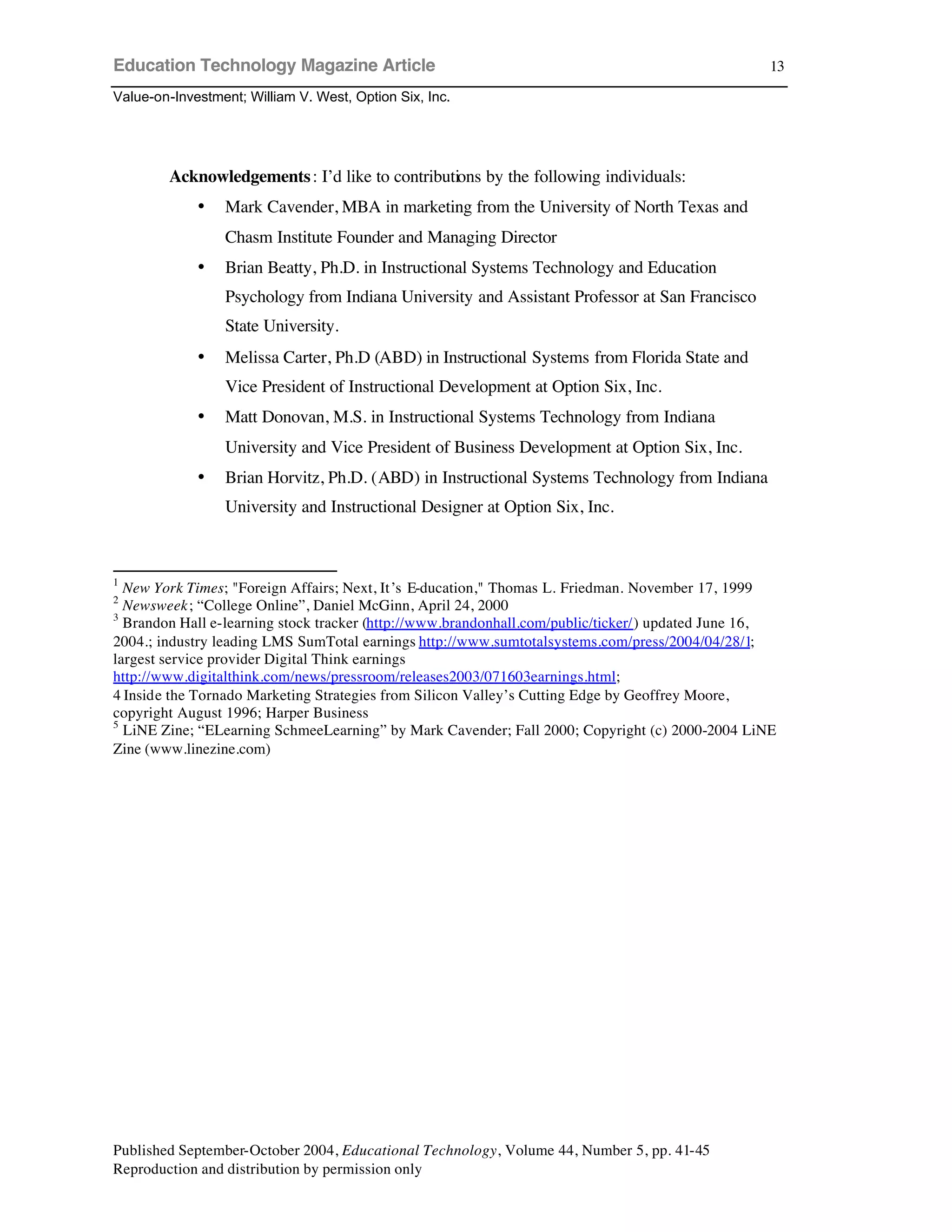This article discusses how e-learning can provide value-on-investment (VOI) rather than just return-on-investment (ROI). It provides examples of e-learning programs that helped companies save significant costs, increase revenue, or improve their market position. Specifically, it describes how e-learning helped a healthcare company reduce TV commercial production budgets, a medical device company shift its focus to branding, and a fast growing restaurant chain maintain quality during expansion. The key is for e-learning to address real business problems and show impact beyond just classroom cost savings.

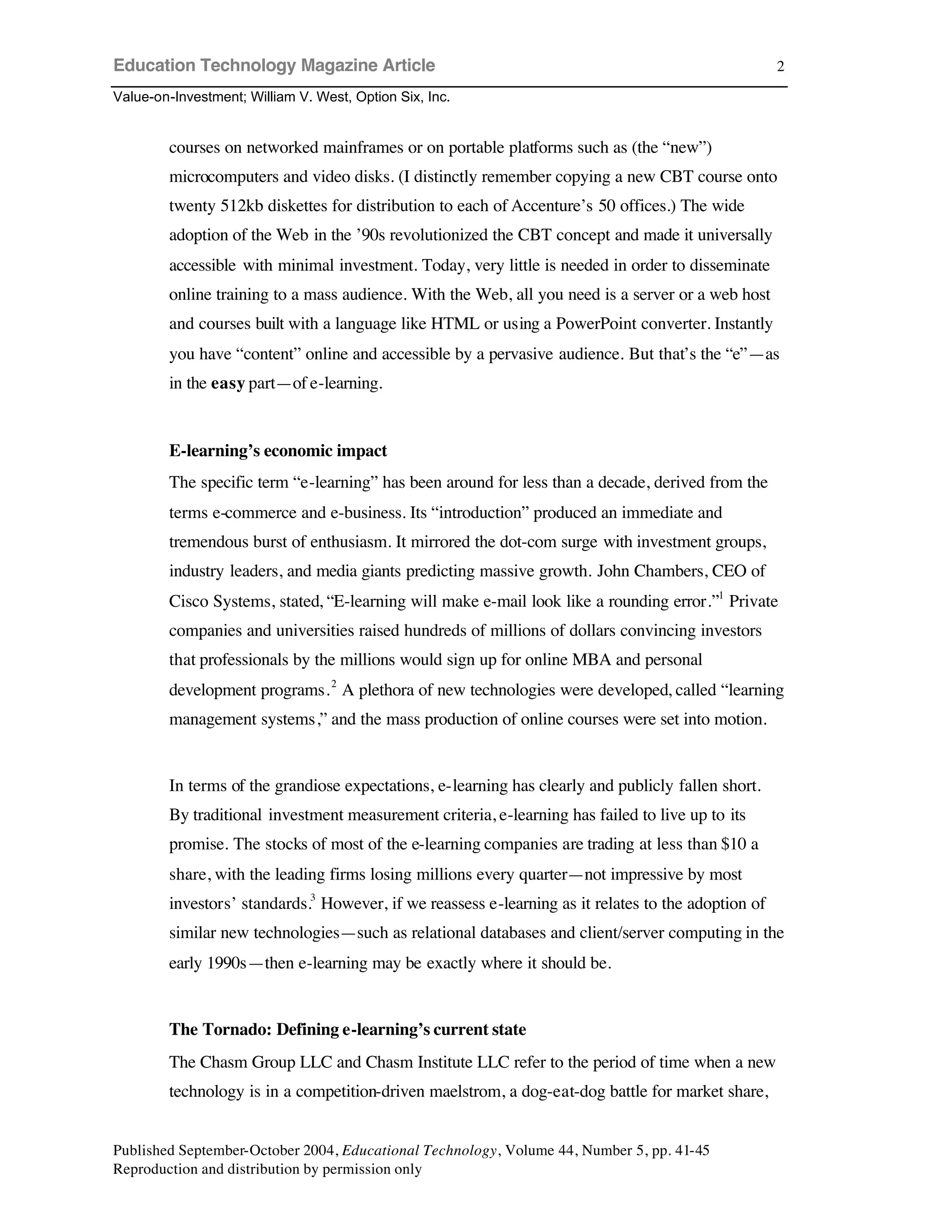
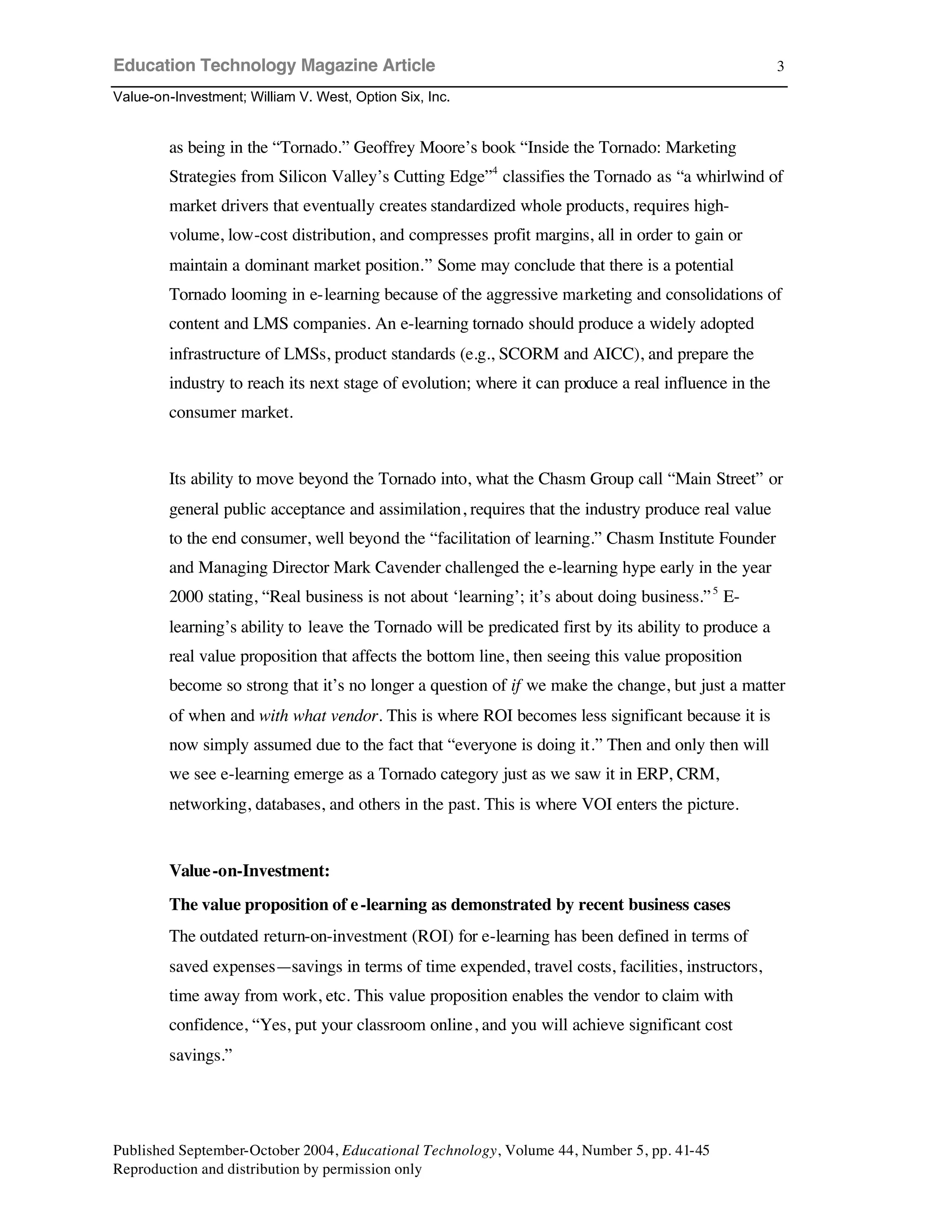
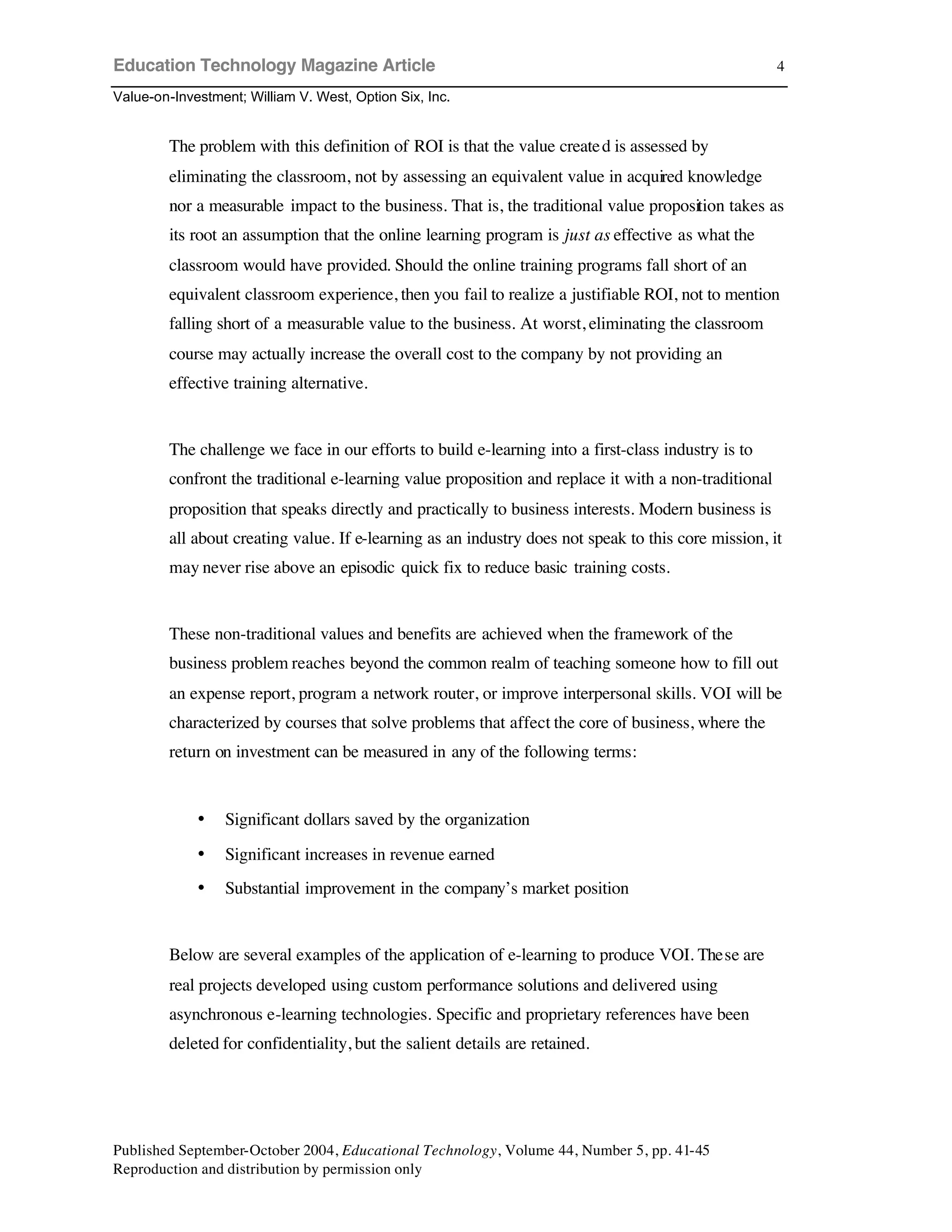
![Education Technology Magazine Article
Value-on-Investment; William V. West, Option Six, Inc.
Published September-October 2004, Educational Technology, Volume 44, Number 5, pp. 41-45
Reproduction and distribution by permission only
5
Television commercial advertisement production
In this instance, a Fortune 100 healthcare company with numerous autonomous operating
divisions was confronted with a continuously difficult problem: staying within production
budget allocated to develop a television ad. As one of the top TV advertisers in the world,
the problem produced millions in cost overruns. Failure of the 3,000 or more marketing
professionals to recognize the core cost drivers of commercial production resulted in
substantial overspending and, worse yet, the failure to reserve budget for the actual
“distribution” of the commercial.
The goal of the [project] was to help marketers become smarter consumers of ad
agencies, take an active role in the production process, and make an informed assessment
of the costs when new creative ideas came into play. The e-learning solution consisted of
an asynchronous learning experience that demonstrated a variety of production
techniques and had them evaluate the appropriateness and cost effectiveness of each
through interactive practice activities. The course incorporated video examples of a wide
range of commercial formats associated with the true cost drivers and the key decision
points that often result in overruns down the line.
For example, one ad characterized the good effects of an analgesic medication for an
elderly person. The primary scenario involved the family at home. Grandma is unable to
play in the yard with her grandchild. She takes the medicine and subsequently is able to
play happily with her grandchildren. Such an ad, utilizing a single production location,
say grandma’s front yard, could be effective and on budget. However, the creative idea
of, say, showing the grandmother skipping happily with her children on a beach at sunset
might easily double or triple the budget. A new location requires different setups, perhaps
different film crews, special timing in order to catch the sunset at “magic hour,” travel
expenses, and related costs that dramatically increase the budget. Being able to recognize
these incremental issues underlying a creative idea and relating them to the key value
plan meant repetitive savings on budget overruns. The overall impact across a global
company with multiple operating divisions is an opportunity to realize VOI—significant
dollars saved by the organization.](https://image.slidesharecdn.com/94344371-0350-47f7-9f79-f7cc5b3babad-170204162920/75/E-learning_Value-on-Investment-5-2048.jpg)
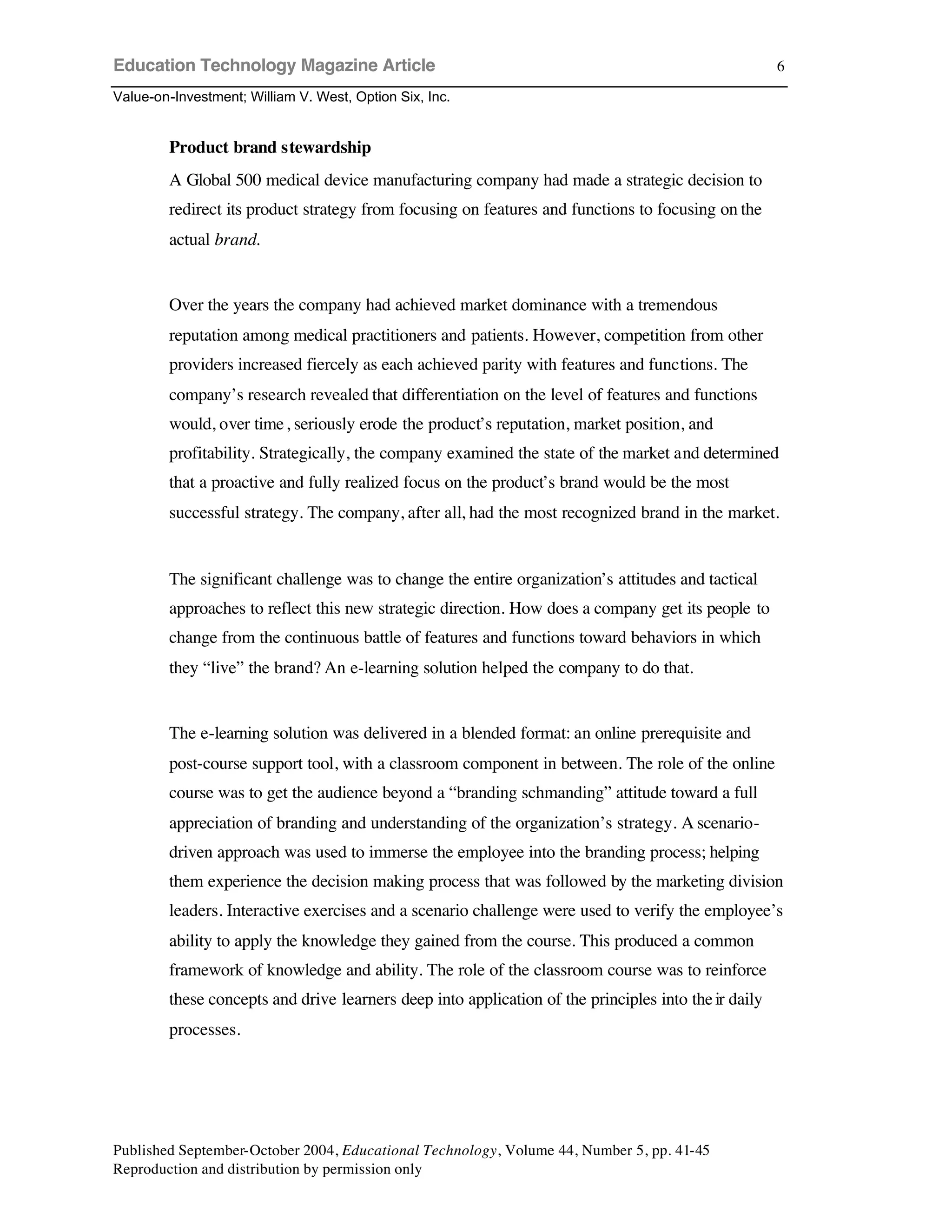
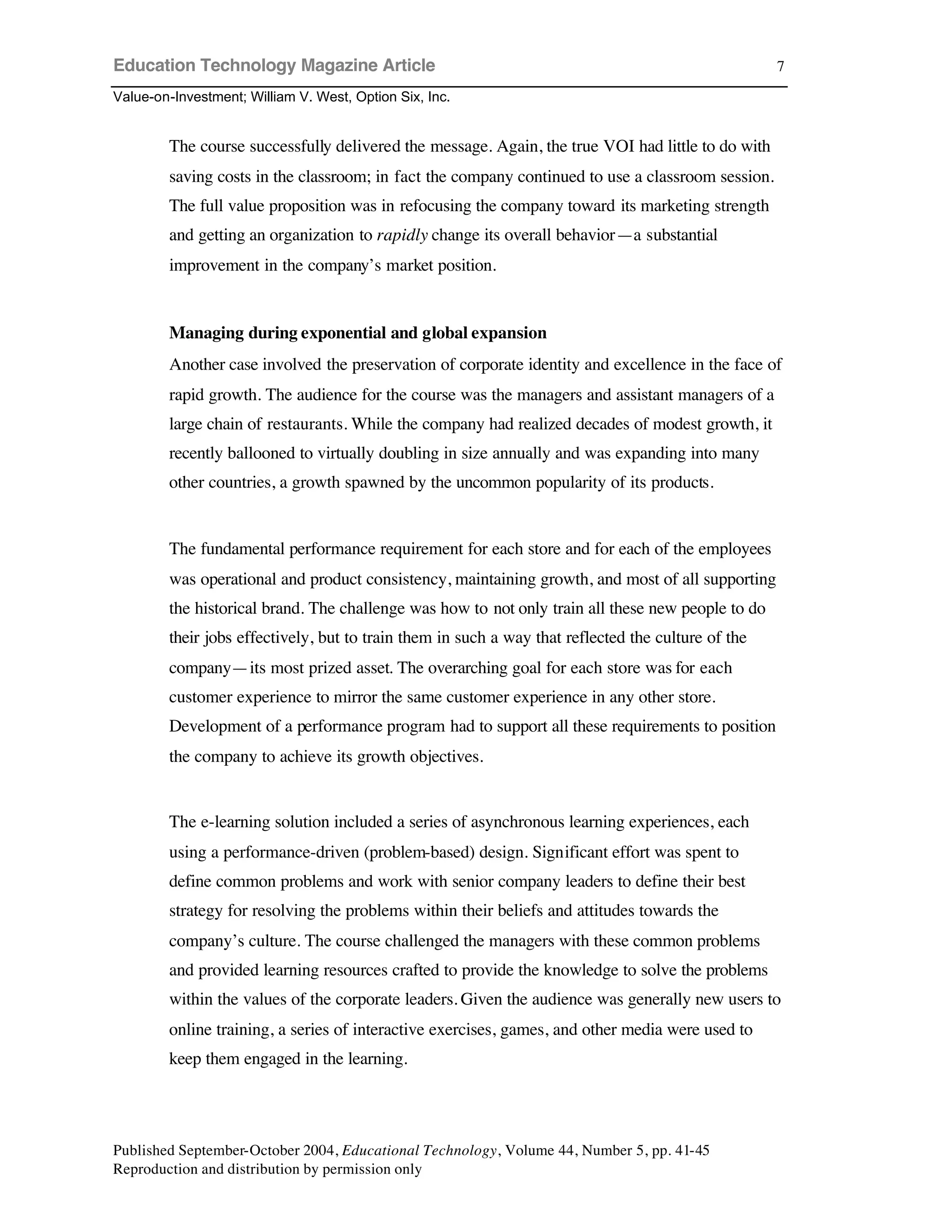
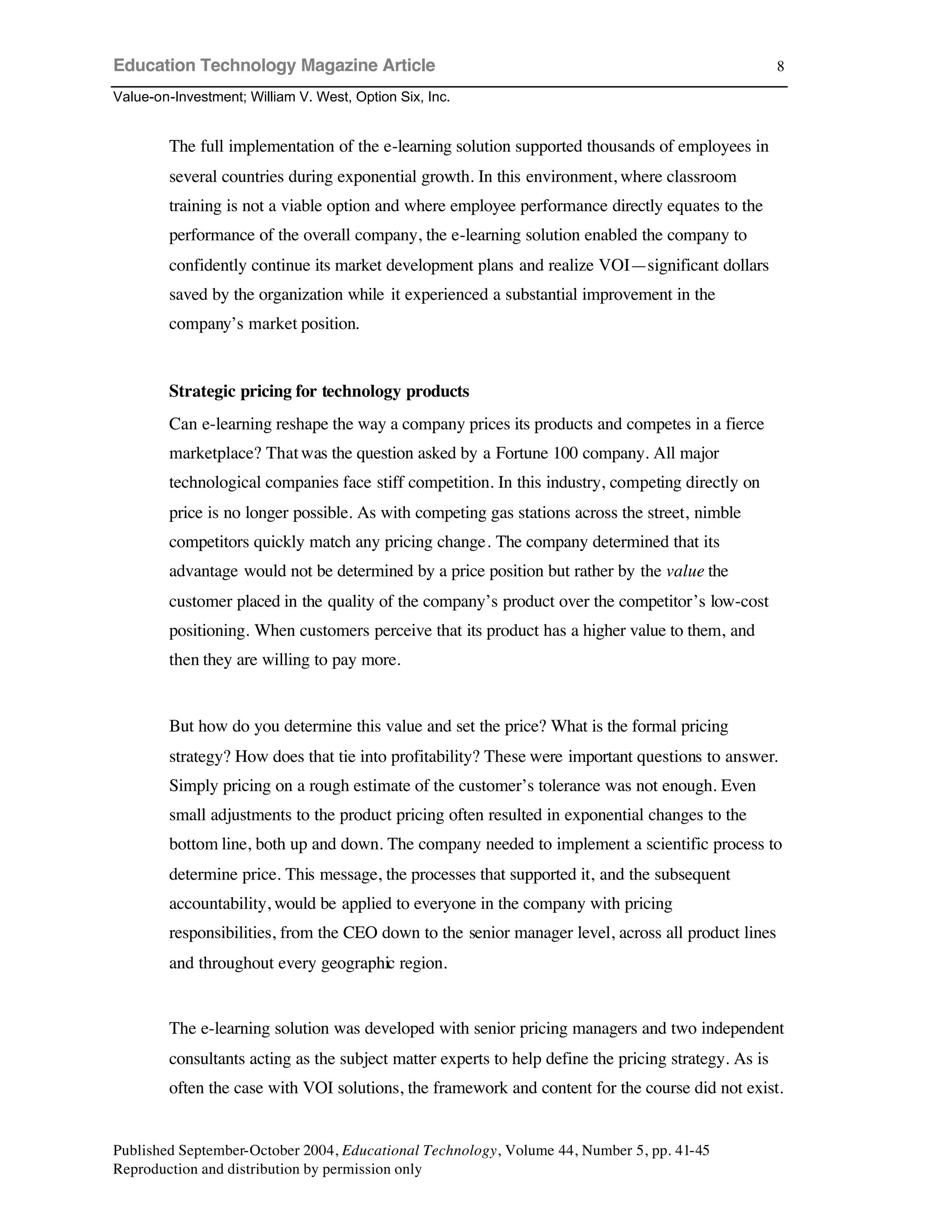
![Education Technology Magazine Article
Value-on-Investment; William V. West, Option Six, Inc.
Published September-October 2004, Educational Technology, Volume 44, Number 5, pp. 41-45
Reproduction and distribution by permission only
9
In other words, the company did not have a standard pricing strategy documented. The
course was developed using a series of case studies to guide the audience through the
price development process and help them understand how to segment their audience and
differentiate their products. Given the audience included all senior managers, from the
CEO down to marketing directors, the assessment strategy needed to be transparent yet
still effective; so a series of applied activities were produced to reinforce the learning
without the use of typical Q&A.
To deploy e-learning to a topic this important and an audience this wide offered the
company “one shot” to get it right. This program carries a tremendous impact to the
overall profitability of the company itself. The VOI of this e-learning program has
nothing to do with traditional ROI of saving costs and getting people through training
cheaply. It has everything to do with the bottom line of the company. The VOI would
produce significant increases in revenue earned.
The current state of e-learning: Poisedto realize its potential
E-learning is poised to enter the “Tornado.” Standards are emerging, increasingly every
major company possesses a learning management and delivery environment, and e-
learning development tools are prevalent. What is required next to make e-learning a
viable tool that produces VOI—real business impact? Once again we can reflect on the
evolution of past technologies, such as client/server computing and relational databases.
Was it the prevalence of hardware and software that [realized the value] of these
developments? Was the plethora of applications built on these tools the catalyst to
enterprise resource planning and customer relationship management systems? No, it was
their availability to experienced, talented service providers who could take the tools and
build solutions that targeted and solved real business problems. During this time, service
practices within Andersen Consulting, Ernst & Young, IBM, other service firms, as well
as multitudes of boutique firms grew exponentially, while enrollments at universities
ballooned with new business analysts, programmers, and system architects.
The fulfillment of a real business value proposition required the availability of new
talent—network engineers, system architects, database analysts, and programmers who](https://image.slidesharecdn.com/94344371-0350-47f7-9f79-f7cc5b3babad-170204162920/75/E-learning_Value-on-Investment-9-2048.jpg)
